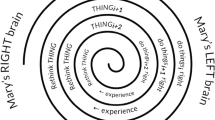Abstract
Several authors have written intriguingly about the right and left hemispheres of the brain. Each hemisphere perceives the world differently, impacting that which it looks upon and reinforcing our particular world view. Notably, the left hemisphere, has always been assumed to be the dominant hemisphere, but only because it has language and is so adept at formulating arguments. The detached mode of the left hemisphere, while useful and necessary to get distance, is no more real than the engaged, imaginative approach of the right hemisphere. Having written about self-sufficiency as a defense against feeling alone and helpless, I now consider these rational, problem solving, answer generating, and planning activities as products of the left hemisphere. The approach that I am suggesting is of calling our patients’ attention to how their left hemisphere overpowers the new, more uncertain voice of the right hemisphere just after it speaks in a session.
Similar content being viewed by others
References
Ackerman, S. (2017). Exploring Freud’s resistance to the oceanic feeling. Journal of the American Psychoanalytic Association, 65, 9–31.
Anderson, M. (2016). The wisdom of lived experience: Views from psychoanalysis, neuroscience, philosophy and metaphysics. London: Karnac.
Bion, W. R. (1967). Notes on memory and desire. Psychoanalytic Forum, 2, 279–80. Also in: Cogitations. London, Karnac. 1992.
Bolte-Taylor, J. (2008, February). Jill Bolte Taylor’s stroke of insight. [Video file]. Retrieved from: http://www.ted.com;talks’jill_bolte_taylor_s_powerful stroke _of_insight.html.
Freud, S. (1884). Letter from Sigmund Freud to Martha Bernays, January 28, 1884. Die Brautbriefe, Vol. 3. G. Fichter, I. Grubrich-Simitis, A. Hirschmüller & W. Kloft (Eds.) Frankfurt a. M.: Fischer Verlag, 2015.
Freud, S. (1912a). The dynamics of the transference. Standard edition, Vol. 12, 97–108. London: Hogarth.
Freud, S. (1912b). Recommendations to physicians practising psycho-analysis. Standard edition, Vol. 12, 109–120. London: Hogarth.
Freud, S. (1913). On beginning the treatment (further recommendations on the technique of psycho analysis). Standard edition, Vol. 12, 123–144. London: Hogarth.
Freud, S. (1914). Remembering, repeating and working through (Further recommendations on the technique of psycho analysis). Standard edition, Vol. 12, 145–156. London: Hogarth.
Freud, S. (1938). An outline of psycho-analysis. Standard edition, Vol. 23, 137–208. London: Hogarth.
Gay, P. (1988). Freud a life for our time. New York, London: W.W. Norton.
Gray, P. (1994). A guide to analysis of the ego in conflict. In: The ego and analysis of defense. (pp. 175–192). Northvale, NJ: Jason Aronson. 2005.
Kernberg, O. F. (2007). The coming changes in psychoanalytic education: Part II. International Journal of Psychoanalysis, 88, 183–202.
Kernberg, O. F. and Michels, R. (2016). Thoughts on the present and future of psychoanalytic education. Journal of the American Psychoanalytic Association, 64, 477–493.
Kuhn, T. S. (1962). The structure of scientific revolutions. Chicago: University of Chicago Press.
Lentz, J. S. (2016). Reconsidering resistance. Psychoanalytic Psychology, 33, 599–-609.
Maness, C. (2017, March 15). Saving Sigmund: Psychoanalysts fight to make Freud relevant again. Boston Globe (STAT)., March 15, 2017. Retrieved from: https://www.statnews.com/2017/03/15/psychoanalyst-freud-relevant/
McGilchrist, I. (2009). The master and his emissary: The divided brain and the making of the Western world. New Haven, CT: Yale University Press.
Melville, H. (1851). Moby Dick. Bantam Classic Reissue. 2003.
Michels, R. (2007). Optimal Education Requires an Academic Context: Commentary on Wallerstein. Journal of the American Psychoanalytic Association, 55, 985–989.
Mullen, G. (2016). Don’t Fence Me in: What is American about American Psychoanalysis?. Journal of the American Psychoanalytic Association, 64, 1225–1234.
Panksepp, J. (1999). Drives, Affects, Id Energies, and the Neuroscience of Emotions Response to the Commentaries by Jaak Panksepp. Neuropsychoanalysis, 1(1):69-89.
Panksepp, J. (2000). On preventing another century of misunderstanding: Toward a psychoethology of human experience and a psychoneurology of affect. Commentary by Jaak Panksepp. Neuropsychoanalysis, 2, 240–255.
Portuges, S. H. (2016). Confronting the Legitimation Crisis: Introduction to Kernberg and Michels. Journal of the American Psychoanalytic Association, 64(3):467-475.
Schore, A. N. (1997). A century after Freud’s project: is a rapprochement between psychoanalysis and neurobiology at hand? Journal of the American Psychoanalytic Association, 45, 807–840.
Schore, A. N. (2011). The right brain implicit self lies at the core of psychoanalysis. Psychoanalytic Dialogues, 21, 75–100.
Solms, M. (2000). Preliminaries for an integration of psychoanalysis and neuroscience. Annual of Psychoanalysis, 28, 179–-200.
Solms, M. and Turnbull, O. (2002). The brain and the inner world: An introduction to the neuroscience of subjective experience. New York: Other Press.
Solow Glennon, S. (2014). The one-sidedness of a dialogue between neuroscience and psychoanalysis. Psychoanalytic Dialogues, 24, 227–235.
Tweedy, R. (2012). The God of the left hemisphere: Blake, Bolte-Taylor, and the myth of creation. London: Karnac.
Vivona, J. (2009). Embodied language in neuroscience and psychoanalysis. Journal of the American Psychoanalytic Association, 57, 1327–1360.
Wallerstein, R. S. (2007). The Optimal Structure for Psychoanalytic Education Today: A Feasible Proposal?. Journal of the American Psychoanalytic Association, 55, 953–984.
Westen, D. and Gabbard, G. O. (2002a). Developments in cognitive neuroscience: I. Conflict, compromise, and connectionism. Journal of the American Psychoanalytic Association, 50, 53–98.
Westen, D. and Gabbard, G. O. (2002b). Developments in cognitive neuroscience: II. Implications for theories of transference. Journal of the American Psychoanalytic Association, 50, 99–134.
Whyte, L. L. (1951). Aspects of form. Bloomington, IN: Indiana University Press.
Wiesel-Barth, J (2014). Does neuroscience contribute to psychoanalysis? Reviews of Judith Rustin’s “infant research and neuroscience at work in psychotherapy,” Terry Marks-Tarlow’s “clinical intuition in psychotherapy: the neurobiology of embodied response,” and Iain McGilchrist’s “the master and his emissary: the divided brain and the making of the western world”. International Journal of Psychoanalytic Self Psychology, 9, 67–75.
Author information
Authors and Affiliations
Corresponding author
Additional information
Address correspondence to Joan Sacks Lentz, Ph.D., 825 Nicolett Mall, Suite 845; Minneapolis, MN 55402 USA.
Rights and permissions
About this article
Cite this article
Lentz, J.S. THE INTERPLAY OF THE TWO HEMISPHERES OF THE BRAIN IN PSYCHOANALYSIS. Am J Psychoanal 78, 217–230 (2018). https://doi.org/10.1057/s11231-018-9145-6
Published:
Issue Date:
DOI: https://doi.org/10.1057/s11231-018-9145-6




